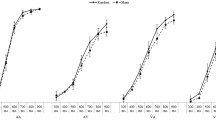Abstract
Numerous studies have suggested that the CNV (contingent negative variation), a negative slow wave developing between a warning and an imperative stimulus, reflects, among other things, temporal processing of the interval between these two stimuli. One aim of the present work was to specify the relationship between CNV activity and the perceived duration. A second aim was to establish if this relationship is the same over the left and right hemispheres. Event-related potentials (ERPs) were recorded for 12 subjects performing a matching-to-sample task in which they had to determine if the duration of a tone (490 ms, 595 ms, 700 ms, 805 ms, and 910 ms) matched that of a previously presented standard (700 ms). CNV activity measured at the FCZ electrode was shown to increase until the standard duration had elapsed. By contrast, right frontal activity increased until the end of the current test duration, even when the standard duration had elapsed. Moreover, for long test durations (805 ms and 910 ms), correlations were observed between CNV peak latency and subjective standard, over left and medial frontal sites. We propose that left and medial frontal activity reflects an accumulation of temporal information that stops once the memorized standard duration is over, while right frontal activity subserves anticipatory attention near the end of the stimulus.




Similar content being viewed by others
References
Belin P, McAdams S, Thivard L, Smith B, Savel S, Zilbovicius M, Samson S, Samson Y (2002) The neuroanatomical substrate of sound duration discrimination. Neuropsychologia 40:1956–1964
Block RA, Zakay D (1996) Models of psychological time revisited. In: Helfrich H (ed) Time and mind. Hogrefe and Huber, Bern, pp 171–195
Brown SW (1997) Attentional resources in timing: interference effects in concurrent temporal and nontemporal working memory tasks. Percept Psychophys 59:1118–1140
Brunia CHM, van Boxtel GJM (2001) Wait and see. Int J Psychol 43:59–75
Brunia CHM, de Jong BM, van den Berg-Lenssen MMC, Paans AMJ (2000) Visual feedback about time estimation is related to a right hemisphere activation measured by PET. Exp Brain Res 130:328–337
Brunia CH, Damen EJ (1988) Distribution of slow brain potentials related to motor preparation and stimulus anticipation in a time estimation task. Electroencephalogr Clin Neurophysiol 69:234–243
Church RM (1984) Properties of the internal clock. Ann N Y Acad Sci 423:566–582
Elbert T, Ulrich R, Rockstroh B, Lutzenberger W (1991) The processing of temporal intervals reflected by CNV-like brain potentials. Psychophysiology 28:648–655
Fraisse P (1984) Perception and estimation of time. Annu Rev Psychol 35:1–36
Gibbon J, Church RM, Meck WH (1984) Scalar timing in memory. Ann N Y Acad Sci 423:52–77
Gratton G, Coles MGH, Donchin E (1983) A new method for off-line removal of ocular artefacts. Electroencephalogr Clin Neurophysiol 55:468–484
Gruber O, Kleinschmidt A, Binkofski F, Steinmetz H, von Cramon DY (2000) Cerebral correlates of working memory for temporal information. Neuroreport 11:1689–1693
Harrington DL, Haaland KY, Knight RT (1998) Cortical network underlying mechanisms of time perception. J Neurosci 18:1085–1095
Ladanyi M, Dubrovsky B (1985) CNV and time estimation. Int J Neurosci 26:253–257
Macar F, Vidal F, Casini L (1999) The supplementary motor area in motor and sensory timing: evidence from slow brain potential changes. Exp Brain Res 125:271–280
Macar F, Vitton N (1980) CNV and reaction time task in man: effects of inter-stimulus interval contingencies. Neuropsychologia 18:585–590
McAdam DW (1966) Slow potential changes recorded from human brain during learning of a temporal interval. Psychonomic Sci 6:435–436
Monfort V, Pouthas V, Ragot R (2000) Role of frontal cortex in memory for duration: an event-related potential study in humans. Neurosci Lett 286:91–94
Pardo JV, Fox PT, Raichle ME (1991) Localization of a human system for sustained attention by positron emission tomography. Nature 349:61–64
Paulesu E, Frith CD, Frackowiak RS (1993) The neural correlates of the verbal component of working memory. Nature 362:342–345
Pfeuty M, Ragot R, Pouthas V (2003) Processes involved in tempo perception: a CNV analysis. Psychophysiology 40:69–76
Posner MI, Petersen SE (1990) The attention system of the human brain. Annu Rev Neurosci 13:25–42
Pouthas V (2003) Electrophysiological evidence for specific processing of temporal information in humans. In: Meck W (ed) Functional and neural mechanisms of interval timing. CRC Press LLC, Boca Raton, FL, USA, pp 439–456
Pouthas V, Garnero L, Ferrandez A-M, Renault B (2000) ERPs and PET analysis of time perception: spatial and temporal brain mapping during visual discrimination tasks. Hum Brain Mapp 10:49–60
Ruchkin DS, Berndt RS, Johnson Jr R, Ritter W, Grafman J, Canoune HL (1997) Modality-specific streams in verbal working memory: evidence from spatio-temporal patterns of brain activity. Cogn Brain Res 6:95–113
Ruchkin DS, McCalley MG, Glaser EM (1977) Event related potentials and time estimation. Psychophysiology 14:451–455
Smith EE, Jonides J (1998) Neuroimaging analyses of human working memory. Proc Natl Acad Sci U S A 95:12061–12068
Walter WG, Cooper R, Aldridge VJ, McCallum WC, Winter AL (1964) Contingent negative variation: an electric sign of sensory-motor association and expectancy in the human brain. Nature 203:380–384
Wearden JH, Denovan L, Fakhri M, Haworth R (1997) Scalar timing in temporal generalization in humans with longer stimulus durations. J Exp Psychol Anim Behav Process 23:502–511
Acknowledgements
The authors thank Vivian E. Waltz for her assistance with the English version of the manuscript. They are also grateful to Florence Bouchet and Laurent Hugueville for their technical competence.
Author information
Authors and Affiliations
Corresponding author
Rights and permissions
About this article
Cite this article
Pfeuty, M., Ragot, R. & Pouthas, V. When time is up: CNV time course differentiates the roles of the hemispheres in the discrimination of short tone durations. Exp Brain Res 151, 372–379 (2003). https://doi.org/10.1007/s00221-003-1505-6
Received:
Accepted:
Published:
Issue Date:
DOI: https://doi.org/10.1007/s00221-003-1505-6




